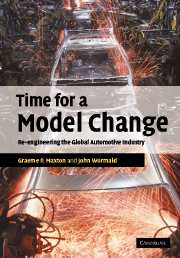Book contents
- Frontmatter
- Contents
- List of figures
- Foreword by G. Fredric Bolling
- Acknowledgements
- Glossary
- Introduction
- 1 From automania to maturity – in the main markets at least
- 2 The problems that can be fixed – dealing with noxious emissions, traffic accidents and congestion
- 3 The global resource challenges – energy and global warming
- 4 A global industry and the changing international order
- 5 The supplier industry – the catalyst for the profound changes to come?
- 6 The downstream sales and service sector
- 7 When the labels do not add up
- 8 Choosing a future for the automotive industry
- 9 Time for a model change
- Index
9 - Time for a model change
Published online by Cambridge University Press: 22 September 2009
- Frontmatter
- Contents
- List of figures
- Foreword by G. Fredric Bolling
- Acknowledgements
- Glossary
- Introduction
- 1 From automania to maturity – in the main markets at least
- 2 The problems that can be fixed – dealing with noxious emissions, traffic accidents and congestion
- 3 The global resource challenges – energy and global warming
- 4 A global industry and the changing international order
- 5 The supplier industry – the catalyst for the profound changes to come?
- 6 The downstream sales and service sector
- 7 When the labels do not add up
- 8 Choosing a future for the automotive industry
- 9 Time for a model change
- Index
Summary
A way out of the impasse – the fourth automotive revolution
In the course of this book, we have identified three major transitions that the industry has gone through in the first hundred years of its existence. Each of them was a revolution, in that it involved a major discontinuity in the organisation of the industry and enabled a leap forward in productivity and cost. In each instance, the manufacturer that provoked the change benefited disproportionately. It changed the rules of the game, upset the competitive equilibrium and leapt ahead of its less perceptive and innovative competitors.
The first three great automotive revolutions are portrayed in figure 9.1 The first huge transition was the epoch-making work of Henry Ford. He leap-frogged over all his craft-based competitors by applying mass-production techniques. The price paid was total standardisation of the product, perhaps even the line worker. In his turn, Sloan leap-frogged over Ford by reintroducing a controlled level of customisation, coupled with divisionalisation and a rational distribution of roles between specialised entities. Then Toyota leap-frogged over the customised mass-producers with lean production. Its competitors stayed in the game by semi-successfully copying leanness and by pushing yet further down the customisation road. Our belief, our argument, is that this further customisation is now well into the zone of diminishing returns, as the industry fails to understand the cost penalties of product proliferation. This is why there is both the need and the opportunity for what we have called the Fourth Revolution.
- Type
- Chapter
- Information
- Time for a Model ChangeRe-engineering the Global Automotive Industry, pp. 257 - 268Publisher: Cambridge University PressPrint publication year: 2004
- 1
- Cited by



